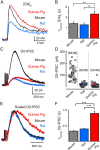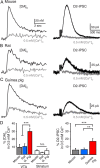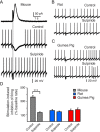Species differences in somatodendritic dopamine transmission determine D2-autoreceptor-mediated inhibition of ventral tegmental area neuron firing
- PMID: 23015441
- PMCID: PMC3538874
- DOI: 10.1523/JNEUROSCI.2745-12.2012
Species differences in somatodendritic dopamine transmission determine D2-autoreceptor-mediated inhibition of ventral tegmental area neuron firing
Abstract
The somatodendritic release of dopamine within the ventral tegmental area (VTA) and substantia nigra pars compacta activates inhibitory postsynaptic D2-receptors on dopaminergic neurons. The proposed mechanisms that regulate this form of transmission differ between electrochemical studies using rats and guinea pigs and electrophysiological studies using mice. This study examines the release and resulting dopamine D2-autoreceptor-mediated IPSCs (D2-IPSCs) in the VTA of mouse, rat, and guinea pig. Robust D2-IPSCs were observed in all recordings from neurons in slices taken from mouse, whereas D2-IPSCs in rat and guinea pig were observed less frequently and were significantly smaller in amplitude. In slices taken from guinea pig, dopamine release was more persistent under conditions of reduced extracellular calcium. The decline in the concentration of dopamine was also prolonged and not as sensitive to inhibition of reuptake by cocaine. This resulted in an increased duration of D2-IPSCs in the guinea pig. Therefore, unlike the mouse or the rat, the time course of dopamine in the extracellular space of the guinea pig determined the duration the D2-IPSC. Functionally, differences in D2-IPSCs resulted in inhibition of dopamine neuron firing only in slices from mouse. The results suggest that the mechanisms and functional consequences of somatodendritic dopamine transmission in the VTA vary among species. This highlights the complexity that underlies dopamine-dependent transmission in one brain area. Differences in somatodendritic transmission would be expected in vivo to affect the downstream activity of the mesocorticolimbic dopamine system and subsequent terminal release.
Figures





Similar articles
-
Cocaine disinhibits dopamine neurons in the ventral tegmental area via use-dependent blockade of GABA neuron voltage-sensitive sodium channels.Eur J Neurosci. 2008 Nov;28(10):2028-40. doi: 10.1111/j.1460-9568.2008.06479.x. Eur J Neurosci. 2008. PMID: 19046384 Free PMC article.
-
In vivo ethanol experience increases D(2) autoinhibition in the ventral tegmental area.Neuropsychopharmacology. 2011 Apr;36(5):993-1002. doi: 10.1038/npp.2010.237. Epub 2011 Jan 19. Neuropsychopharmacology. 2011. PMID: 21248720 Free PMC article.
-
Inhibitory inputs from rostromedial tegmental neurons regulate spontaneous activity of midbrain dopamine cells and their responses to drugs of abuse.Neuropsychopharmacology. 2012 Apr;37(5):1164-76. doi: 10.1038/npp.2011.302. Epub 2011 Dec 14. Neuropsychopharmacology. 2012. PMID: 22169942 Free PMC article.
-
The somatodendritic release of dopamine in the ventral tegmental area and its regulation by afferent transmitter systems.Neurosci Biobehav Rev. 2004 Jul;28(4):415-31. doi: 10.1016/j.neubiorev.2004.05.001. Neurosci Biobehav Rev. 2004. PMID: 15289006 Review.
-
Ventral tegmental area neurons in learned appetitive behavior and positive reinforcement.Annu Rev Neurosci. 2007;30:289-316. doi: 10.1146/annurev.neuro.30.051606.094341. Annu Rev Neurosci. 2007. PMID: 17376009 Review.
Cited by
-
Somatodendritic dopamine release: recent mechanistic insights.Philos Trans R Soc Lond B Biol Sci. 2015 Jul 5;370(1672):20140185. doi: 10.1098/rstb.2014.0185. Philos Trans R Soc Lond B Biol Sci. 2015. PMID: 26009764 Free PMC article. Review.
-
D2/3 Agonist during Learning Potentiates Cued Risky Choice.J Neurosci. 2023 Feb 8;43(6):979-992. doi: 10.1523/JNEUROSCI.1459-22.2022. Epub 2023 Jan 9. J Neurosci. 2023. PMID: 36623876 Free PMC article.
-
Preservation of dendritic D2 receptor transmission in substantia nigra dopamine neurons with age.Sci Rep. 2023 Jan 19;13(1):1025. doi: 10.1038/s41598-023-28174-2. Sci Rep. 2023. PMID: 36658269 Free PMC article.
-
Complexes of Ghrelin GHS-R1a, GHS-R1b, and Dopamine D1 Receptors Localized in the Ventral Tegmental Area as Main Mediators of the Dopaminergic Effects of Ghrelin.J Neurosci. 2022 Feb 9;42(6):940-953. doi: 10.1523/JNEUROSCI.1151-21.2021. Epub 2021 Dec 7. J Neurosci. 2022. PMID: 34876469 Free PMC article.
-
The role of D2-autoreceptors in regulating dopamine neuron activity and transmission.Neuroscience. 2014 Dec 12;282:13-22. doi: 10.1016/j.neuroscience.2014.01.025. Epub 2014 Jan 23. Neuroscience. 2014. PMID: 24463000 Free PMC article. Review.
References
-
- Aghajanian GK, Bunney BS. Dopamine“autoreceptors”: pharmacological characterization by microiontophoretic single cell recording studies. Naunyn Schmiedebergs Arch Pharmacol. 1977;297:1–7. - PubMed
-
- Barbour B, Keller BU, Llano I, Marty A. Prolonged presence of glutamate during excitatory synaptic transmission to cerebellar Purkinje cells. Neuron. 1994;12:1331–1343. - PubMed
-
- Beckstead MJ, Grandy DK, Wickman K, Williams JT. Vesicular dopamine release elicits an inhibitory postsynaptic current in midbrain dopamine neurons. Neuron. 2004;42:939–946. - PubMed
Publication types
MeSH terms
Substances
Grants and funding
LinkOut - more resources
Full Text Sources
Miscellaneous
